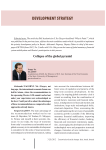Economic and Social Changes: Facts, Trends, Forecast @volnc-esc-en
Статьи журнала - Economic and Social Changes: Facts, Trends, Forecast
Все статьи: 1728
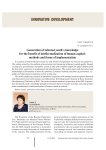
Child population in Russia: main problems of development
Статья научная
The article presents a comprehensive analysis of the problems of childhood in modern Russia, the relevance of which determine the severity of the socio-economic transformations of a society in which this part of the population is most vulnerable. At the same time investments in children's development - an investment in future human capital of the country. The results of this study allowed the author to highlight three laps problems associated with “the field of childhood”. First round - problems related to the scope, size and structure of children. The second set of problems related to analysis of conditions and institutions of formation of childhood. The third set of problems of the younger generation in Russia - is an unprecedented deterioration in health. Thus, the main objective of social policy is to improve the quality potential of children in the context of reducing their numbers. In the first place in this context is the task of improving health, from birth, followed by education and socialization throughout their internal relationship as a foundation for the development of system programs of public policy with regard to childhood.
Бесплатно
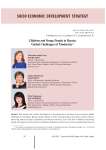
Children and young people in Russia: global challenges of modernity
Статья научная
The present-day world’s development is becoming more and more uneven and new global challenges are emerging. Russia should respond to them by enhancing its economic competitiveness, preserving and increasing its population and human potential, first of all, that of children and young people. The paper points out that for the Russian Federation with its vast territory and substantial reserves of natural resources the most important geopolitical challenges consist in the preservation and increase of population and human potential. The authors prove that the formation of the population of Russia is under double “pressure” of high mortality and low fertility; therefore, natural movement (decline) is not completed by mechanical movement. In addition, the article determines that the share of young people in the total population is decreasing. For the first time in the history of Russia the share of children has become lower than the proportion of the elderly. In 2013 in 56 Russian regions, the proportion of children and adolescents accounted for less than 20% of the population (in the early 2000s, there were 41 such regions, and in 1990 - three)...
Бесплатно
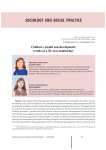
Children's health and development: results of a 20-year monitoring
Статья научная
The analysis of the data from domestic and foreign theory and practice has shown that the monitoring of the cohort of children is the most effective method of studying and assessing the health and development of children in order to make efficient and adequate management decisions. The paper presents the results of the medical-and-sociological monitoring “Research into the conditions for the formation of a healthy generation”, performed by RAS Institute of Socio-Economic Development of Territories since1995 with the active support on the part of the Vologda Oblast Department of Healthcare. The authors have found out that each age period is characterized by a specific set of factors influencing health. Infancy and early age are dominated by the impact of medico-biological and social factors (poor health of the parents; low level of hemoglobin during pregnancy; mother’s smoking during pregnancy; labour conditions of the mother that do not meet sanitary standards; specifics of the infant’s feeding)...
Бесплатно
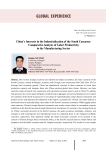
Статья научная
Due to their strategic location and relatively developed economies, the three countries of the South Caucasus, namely Azerbaijan, Armenia, and Georgia, have cooperated with China since 2015 to leverage their economic growth. China has significantly invested in these countries to boost their productive capacity and integrate them into China-centered global value chains. However, are these countries ready to launch into cooperation with advanced economic powers such as China? To address this question, the current paper integrates overall trends in aggregate and sectoral productivity to evaluate the readiness of the South Caucasus for a new phase of industrialization using Chinese investments and projects as new and important developments in the region’s economic life. Overall, the results indicate a downward trend in manufacturing value added in the South Caucasian economies. While lagging trends raise concerns, Chinese foreign directed investment may resolve issues related to incomplete capacity utilization in the South Caucasus through infrastructure investments. In contrast to the existing literature on China’s economic presence in the South Caucasus, this paper examines Azerbaijan, Armenia, and Georgia in both intraregional and interregional terms by comparing them to the Visegrad and Baltic countries, respectively. This approach enables the South Caucasian countries to be situated in the context of Chinese foreign direct investments influx, as the South Caucasus shares a similar history and prospects with the Baltic countries and the Visegrad countries, respectively. The results of a one-sample t-test indicate that, on average, capital deepening and aggregate labor productivity are higher in the South Caucasus than in the Visegrad and Baltic regions. However, manufacturing labor productivity was significantly lower in the South Caucasus than in the benchmark regions. Moreover, the estimated effect sizes at the sectoral level - as measured through eta squared - illustrated the strength of the obtained differences. These findings document the need for improved economic reforms and policies to keep pace with the regions that are driven by foreign direct investments and that have successfully integrated into global value chains. Otherwise, China-led economic development may fail to industrialize the South Caucasus, misguiding the respective parties’ beliefs and expectations. Thus, further research is needed alongside specific sectoral policy strategies to document country- or region-specific challenges related to the increase in Chinese projects and foreign direct investments in the South Caucasus.
Бесплатно
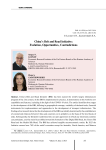
China’s Belt and Road Initiative: Evolution, opportunities, contradictions
Статья научная
China’s Belt and Road Initiative (BRI) has been named the world’s largest infrastructure program of the 21st century. As the BRI is implemented in practice, it demonstrates to the world its new capabilities and features, including in the light of the COVID-19 crisis. The article identifies three stages in the development of the BRI, differing in geographical coverage, variability of declared tasks, financial instruments for implementation and approaches to the development of transport infrastructure. The findings of our research show that the development of the BRI was initially determined by the establishment of commercial relations between China and countries on its periphery on the basis of five key blocks of tasks. Subsequently, the Initiative transformed into an open agreement in which any interested countries can participate, and the main focus shifted toward the formation of the Digital Silk Road, the Green Silk Road and the Health Silk Road. The BRI has achieved tangible macroeconomic results. By 2025 the Initiative covered over 70% of the world’s countries except for Australia, North America, and Western Europe. Reliable prerequisites have been created for the expansion of Chinese companies abroad, based on government financial support, significant production investments and the possibility of using improved infrastructure. Given its extensive geographical coverage and economic scale, the development of the BRI is an important event in shaping a new network of global transport corridors. However, the criteria for including infrastructure facilities in the list of projects under the BRI are still unclear. As for potential concerns of the countries involved in the Initiative, some of them include possible threats of an influx of labor from China, loss of control over strategic assets, use of less environmentally friendly technology, and increased financial dependence on China.
Бесплатно
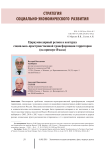
Circumpolar region amid socio-spatial transformation of a territory (case study of Yamal)
Статья научная
The article examines the issues of socio-spatial transformation of the Northern territory associated with the development of one of the most important far-reaching oil and gas region of Russian arctic regions. The authors demonstrate the possible solutions to these issues based on interdisciplinary and sociological studies conducted by the authors and their colleagues, including mass surveys of the population of the Yamalo-Nenets Autonomous Okrug by representative sample in 2005, 2010 and 2015 and sociological diagnostics of their results in the context of different social groups of respondents (long-term residents, including representatives of native minorities, new settlers, shift personnel). These studies have helped reveal the social issues characteristic of the Arctic region and requirements to scientific support of possible their possible solutions. The authors provide the authorities with the information necessary for the preparation and adoption of effective managerial decisions in the theoretical, methodological and practical discourse; such information cannot be obtained otherwise, for example, using the statistics...
Бесплатно
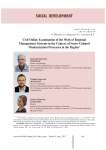
Статья научная
The study is part of a hybrid methodology that combines field and remote methods for collecting primary sociological data. The goal of the study is to verify and show the capabilities of expert online survey in studying the issues of reforming the power and management hierarchy in conjunction with the data from official sources, representative field survey, content analysis of the regional media and online studying of network communities in regions with different levels of socio-cultural modernization, which are used as a whole in the study under a Russian Science Foundation grant. The paper presents summarized results of the initial stage (in four out of twelve regions of the Russian Federation) of this study aimed to obtain representative data on the work of government and management authorities in the context of socio-cultural modernization in individual regions, to identify relations that affect the functionality of regional administration systems, which determine the nature and level of their development, and the ability of regional power and management vertical to effectively solve socio-economic problems...
Бесплатно
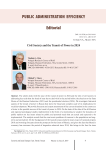
Civil society and the transit of power in 2024
Статья научная
The article deals with the issue of the transit of power in 2024 and the role of civil society in addressing key tasks that the head of state has to deal with in the period before the election to the State Duma of the Russian Federation (2021) and the presidential election (2024). We investigate historical aspects of the transit of power in Russia that show the broad and complex scale of its implications for social development. We provide forecasts and expert assessments of the current situation in the country as a factor in the possible success of the transit of power in 2024. On the basis of the data of the all-Russian and regional sociological studies implemented in the form of a monitoring we analyze the dynamics of public opinion on key issues related to public and personal needs that are actual and expected to be implemented. The analysis reveals that the most acute problems of concern to the population are long-term and unresolved. On the background of the launch (unsuccessful in many ways) of national projects 2018 and worrying forecasts about the prospects for the future of Russia, and given the fact that Russia’s economy has overcome the period of stagnation observed since 2014, this brings to the fore the issue concerning the effectiveness of public administration in the new political cycle in which (according to the Constitution of the Russian Federation) Vladimir Putin will not be able to take the post of head of state. In the “transit” period (the period remaining until the State Duma election of 2021 and the presidential election of 2024), the President has to deal with the tasks of a higher level. One of them is related to the implementation of the potential of civil society accumulated over the past 20 years, since civil society is an active entity representing the interests of the general population in dialogue with the authorities at all levels of government. The solution to this problem can guarantee a successful “transit” of the Russian society in a new historical period.
Бесплатно
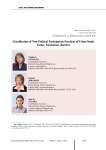
Classification of non-political participation practices of urban youth: forms, motivation, barriers
Статья научная
The article explores civic (non-political) participation practices among young people, which are understood as voluntary, public, and altruistic individual or collective actions. They are viewed as a condition for allowing young people to exercise their right to the city and are aimed at transforming urban space. The role of citizens in modern urban centres is increasing; they are becoming not only users, but also co-authors. Local activities that transform the territory in which young people live lead to an increase in their self-esteem and confidence, the acquisition of soft skills, and the formation of norms of interpersonal interaction. This study's main aim is to identify types of youth civic participation in a large industrial city. Drawing on data from an online survey (quota sampling, n = 800) of young people in the large industrial city of Yekaterinburg (Russia) conducted at the end of 2020, we suggest a typology of civic participation practices. The types were identified through the experience of participation in activities aimed at exercising a right to the city, a willingness to collaborate with other people, the degree of the institutionalisation of civic practices, and motivation to participate or not participate in civic practices. The article argues for building a constructive dialogue with government authorities to meet the needs of young people in transforming urban space. Studying specific do-it-yourself urban design practices in different cities and territories to find the most successful models for potential replication may be a promising direction for further research.
Бесплатно
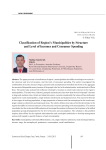
Classification of region's municipalities by structure and level of incomes and consumer spending
Статья научная
The paper presents a classification of region's municipalities that differ according to two criteria - the structure and level of incomes, and the level of consumer spending. The author investigated the combination of income sources (wages, pensions and unemployment benefits) that form in the aggregate the amount of disposable money income of the people who live in the administrative-territorial units of Perm Krai. The author also analyzed the influence of people's incomes on retail trade turnover in the region's municipalities. The data were collected, grouped and analyzed; they show that the level of people's income in large and medium cities, which are industrial centers, exceeds considerably the values of these indicators registered in rural municipalities, single-industry settlements and depressed areas. The reason for this lies in low wages of working population, a large proportion of retirees and the unemployed in the rural areas, single-industry settlements and depressed areas...
Бесплатно

Статья научная
The article presents results of the research in the differentiation of Russian subjects by birth rate of fourth and subsequent children, depending on the region's socio-economic development level for the period of 2005-2017. The authors conduct cluster analysis based on Ward's method of time series of 3 groups of indicators, particularly demographic, economic and social, in the regional context. As a result, they identify 6 clusters, describing the situation of Russian subjects, depending on the values of the birth rate of fourth and subsequent children and indicators of socio-economic development of the region for 2005-2017. The study reveals that in the period under review there are two main trends: first, transition of RF subjects from Cluster 1, characterized by sufficiently high values of the birth rate of fourth and subsequent children and low indicators of socio-economic development, to the clusters with a lower value of the coefficient and higher indicators of socio-economic development; second, transition of RF subjects from the clusters with a low birth rate of fourth and subsequent children to the clusters characterized by the increased birth rate against the background of improved socio-economic development. In the current period, it is possible to distinguish the formation of two poles of large families - these are “the poor with many children” regions, in which a high birth rate of fourth and subsequent children is associated with low socio-economic development, and “the rich with many children” regions with high birth rates and a high level of socio-economic development. Between them there are other RF subjects, which are gradually moving away from the pole of “the poor with many children”, but have not approached the pole of “the rich with many children” yet. The novelty of the study lies in the application of the author's approach to the analysis of relationship between large families and socio-economic development of Russian regions in the temporal dimension.
Бесплатно
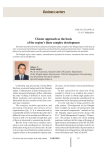
Cluster approach as the basis of the region's linen complex development
Статья научная
The article describes the direction of future development of flax complex in the Vologda region on the basis of inter-sectoral and interterritorial cooperation and the formation of regional industrial cluster. Implementation phases of a special pilot project and the expected economic results of its implementation are presented.
Бесплатно
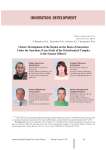
Статья научная
In modern conditions, ensuring rapid economic development is a priority task for industrial policy, but its achievement is hampered by the sanctions imposed on Russia. Russian oil industry has become an object of special attention to the countries that initiated the sanctions. The goal of the paper is to substantiate a set of practical measures that promote cluster development through innovation as an opportunity to facilitate economic growth in the region under the sanctions. In the framework of the goal we achieve the following objectives: we substantiate the cluster approach as a theoretical framework for the innovation-driven development of the industrial complex; we explore the current state and the value of the petrochemical complex in the economy of the Samara Oblast; we justify the stages of formalization of the industrial cluster on the basis of innovation. Scientific novelty of the research consists in the fact that it expands the existing system of knowledge about economic sanctions not only as a tool of political pressure, but also as a resource for priority development of regions...
Бесплатно
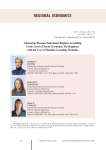
Статья научная
The paper solves the problem of clustering Russian Federation regions according to their socioeconomic development, taking into account the sectoral structure of the gross regional product. Classical machine learning methods are a tool for solving the clustering problem. The object of the study is the differentiation of regions according to various socio-economic indicators. The subject of the study is the practice of using machine learning methods for clustering objects. The initial database for solving the problem of clustering regions includes actual statistical data on socio-economic development of RF constituent entities and the sectoral structure of their gross regional product as of 2019. We identify clusters of regions according to their socio-economic development with the use of modern machine learning methods implemented in Python, a high-level programming language, with the connection of libraries for working with data: Pandas, Sklearn, SciPy, etc. The preprocessing of the initial data was carried out: digitization of data categories, transition to specific values, standardization of indicators. The initial data set for 2019 contains 5,525 records on 65 indicators of socio-economic development for 85 regions of the Russian Federation. It identifies 15 basic indicators of socio-economic development of a region, based on the principal component analysis. According to these indicators, five regional clusters were identified with the use of the k-means clustering: the first cluster is characterized by a high share of wholesale and retail trade, real estate transactions, professional, scientific and technological activities in the GRP structure; the second cluster specializes in manufacturing, wholesale and retail trade, real estate transactions, agriculture and forestry; the third cluster can be described as a cluster with a mixed economy, which is characterized by averages for the main socio-economic indicators in the Russian Federation; regions of the fourth cluster show a high level of unemployment and a high share of public administration, military and social security; the fifth cluster specializes in mining.
Бесплатно
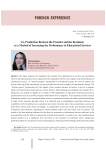
Статья научная
The paper proposes the shaping of the concept of co-production in services and specifically refers to the educational process, respectively the cooperation between the supplier and the beneficiary of educational services. A “teacher-student” partnership is considered because we want to capture the system made up of the educational services provider and the active subject of educational training. The “teacher-parent” partnership isn't the subject of our research because we believe it may be a separate subject of research that transcends our current interest. After defining and clarifying the concept of co-production, an analysis is applied to a number of 500 respondents in education by giving concretely a questionnaire such as to provide adequate information for our purposes. The importance of the research undertaken resides in the conceptualization of the co-production between the offerer and the beneficiary in light of the elements through which it is reflected and in establishing connections between the availability of the beneficiaries to coproduce and certain elements taken into consideration such as the belief there will be some future advantages...
Бесплатно
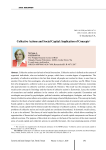
Collective actions and social capital: implication of concepts
Статья научная
Collective actions are the basis of social interaction. Collective action is defined as the system of organized individuals, who are included in groups, which have a certain degree of organization. The pecularity of collective activities is the fact that almost all people are involved in them, in one form or another. One of the first sociologists, who started the study of collective activities, was M. Weber. It was him who designated a collective action as a social one. While studying consumer behavior, economists also paid attention to collective activities of people (E. Ostrom). The result was the emergence of the social action concept in Sociology and the theory of collective action in Economics. Later, the number of researchers and studied problems in the context of a collective action expanded. Economists and sociologists were joined by psychologists, political scientists, anthropologists, biologists, and others. The theory of collective action allows us to explain a wide range of social life phenomena. This concept is closely related to the theory of social capital, which emerged at the intersection of economic and social sciences. Social capital is a factor that determines the intensity, effectiveness, and mass scale of collective actions. However, social capital itself is formed under the influence of collective actions. In foreign science, the problems of collective action and social capital are considered interrelated. In domestic social science, it is yet to be achieved. The theory of social capital has the umbrella effect, which allows searching for opportunities of theoretical and methodological integration of social capital components and forms of collective actions. The purpose of this article is to show, on the basis of the overview of the main research areas of social capital and collective actions in scientific literature, the most promising points of their contact for studying social reality in Russia. It includes the research of subjects of collective actions, transformation of their goals, the enrichment of the repertoire due to the emergence of new practices and the usage of virtual space. The important aspect is the environment for the implementation of collective actions, which forms their target orientation. The implication of concepts of social capital and collective action should allow us to identify aspects of mutual influence between them.
Бесплатно
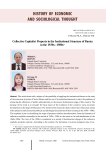
Collective capitalist property in the institutional structure of Russia in the 1930s-1980s
Статья научная
The article deals with a subject of the possibility of applying the institutional theory to the study of the economic structure of Soviet Russia and the use of its individual elements to solve the problems of improving the efficiency of public administration at the present development stage of this country. The purpose of the work is to consider the basic issues of the evolution of the country’s socio-economic development at the stage of bifurcation. The novelty of the research is that it shows the evolutionary trends of the property institute and the political and ideological mechanisms of their ensuring in the 1930s-1980s. The emphasis is put on identifying the stages of property relations transformation: from the formation of collective capitalist ownership in the period of 1930s-1950s to the trends to its individualization in the 1960s-1980s. The turn of the 1990s is considered as a period of fundamental change of the collective capitalist property institute. According to the authors, the formation of a proto-bourgeois class of co-owners, which provided capitalist tendencies in the society’s development, was of great importance in Soviet times. The article shows the ideological content of trends leading to the capitalist transformation of Russia, which consist in justifying the property rights concentration. The change in the social base of the ruling class formation, the inclusion of the representatives of the intellectuals’ class and the intelligentsia in its composition were quite important in this process. It is noted that privatization in the course of market transformations broke the existing property relations in the Soviet period and led to an increase in social inequality. The authors emphasize the urgent need to restructure modern state policy in terms of taking into account the mentality of the “Russian life” and economic traditions that developed during the Soviet period.
Бесплатно
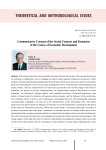
Communicative concept of the social contract and formation of the course of economic development
Статья научная
The article presents the communicative concept of the social contract. This concept focuses not on reaching a compromise, but on bringing the parties closer together during the discussion of their positions. Mutual understanding regarding the desired future of the socio-economic system is a necessary basis for determining the course of economic development with a communicative understanding of the social contract. Such an interpretation of it takes into account that not only the image of the future is important, the process of its joint comprehension, the organizational aspect of this process is no less important. As evidenced by foreign practice, with standard procedures of electoral democracy, state policy is formed under the influence of business-oriented groups, and the influence of the preferences of an ordinary citizen is close to zero. Information technologies have not only dramatically expanded communication capabilities, but also led to the identification of the information elite. The article analyzes the discussion about the influence of this elite on social development, including the discussion of the theory of information autocracy. When mass media leads to increased polarization of society, it increases investment risks and causes a slowdown in economic growth. As foreign studies show, a new technological elite occupies a special position on topical issues of modern socio-economic development. The elite is interested not only in new technological and economic results, but also in social progress. The strong support of the high-tech elite for income redistribution and progressive taxation allows us to take a fresh look at the prospects for the convergence of the positions of social clusters regarding the course of economic development. The communicative concept of the social contract is a suitable basis for the synthesis of ideas of social clusterism and collaborative democracy.
Бесплатно
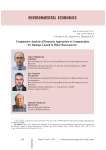
Comparative analysis of domestic approaches to compensation for damage caused to water bioresources
Статья научная
Issues related to renewable natural resources and compensation for damage to resources as a result of economic activities are in the focus of Russian and foreign scientists. The article presents domestic approaches to compensation for harm caused to water bioresources and their habitats. The purpose for the research is to conduct comparative analysis of two existing Russian approaches to compensation for harm caused to water bioresources: as a result of economic activities (construction of facilities, pipeline stringing., etc.) and illegal fishery of water biological resources (poaching). The authors conduct analysis of open data on water biological resources linkage, fishery yield and value characteristics of compensation through artificial reproduction of water bioresources as the main direction of natural resource recovery. The authors use data on the Arkhangelsk and Murmansk oblasts, Republic of Karelia, Komi Republic. They cover the issues of damage compensation from illegal extraction of water bioresources with use of the fixed charge approach...
Бесплатно

